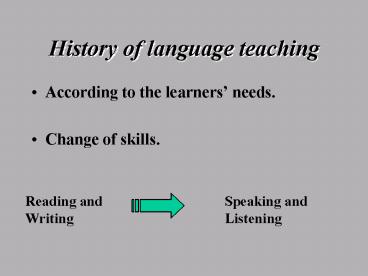History of language teaching - PowerPoint PPT Presentation
1 / 12
Title:
History of language teaching
Description:
Phonetic training. The use of dialogues to introduce conversational phrases and idioms. ... Include phonetics in teaching and teachers. ... – PowerPoint PPT presentation
Number of Views:494
Avg rating:3.0/5.0
Title: History of language teaching
1
History of language teaching
- According to the learners needs.
- Change of skills.
Reading and Writing
Speaking and Listening
2
- 18th 19th century Modern languages were taught
using the same basic procedures that were used
for teaching Latin - GRAMMAR RULES-LISTS OF VOCABULARY-SENTENCES FOR
TRANSLATION.
3
19th century innovations
- Increasing demand for oral proficiency in foreign
languages as Europeans travelled. - Marcel (1793-1896) child language learning.
Reading - Prendergast (1806-1886) Childrens use of
situational cues to interpret utterances and
memorized phrases and routines in speaking.
First structural syllabus. - Gouin (1831-1896) Children language. Use of
gestures and actions.
4
The Reform Movement (around XXth century)
- New ideas discussed in books, articles,
pamphlets... - Specialists sought new ideas and advocated
- The study of the spoken language.
- Phonetic training.
- The use of dialogues to introduce conversational
phrases and idioms. - An inductive approach to the teaching of grammar.
- Avoidance of the mother tongue.
5
The Reform Movement
- Henry Sweet (1845-1912)
- The Practical Study of Languages
- Careful selection of what is to be taught.
- Imposing limits on what is to be taught.
- Four skills listening, speaking, reading and
writing. - Grading materials from simple to complex.
6
General considerations of the Reform Movement
(Sweet, Viëtor).
- The spoken language is primary.
- Include phonetics in teaching and teachers.
- Learners should hear the lang first, before
seeing it in written form. - Sentences should be taught in meaningful
contexts. - Grammar should be taught inductively.
- Avoid translation. Use mother tongue to clarify.
7
The Direct/Natural Method (until 1920s)
- Sauveur (1826-1907) in Europe Berlitz in the
USA Berlitz Method (commercial lang schools) - Classroom instruction in Target lang.
- Learning based on everyday vocabulary
sentences. - Small and intensive classes.
- Oral communication skills in graded progression.
Communicative exchanges between student-teacher. - Grammar taught inductively.
- Use of demonstration, objects and pictures in
class.
8
Principles of the Berlitz school
- Never translate demonstrate.
- Never explain act.
- Never make a speech ask questions.
- Never imitate mistakes correct.
- Never speak with single words use sentences.
- Never use the book use your lesson plan.
- Never go too fast keep the pace of the student.
- Never speak too slowly speak normally.
- Never speak too quickly/loudly speak naturally.
- Never be impatient take it easy.
9
1923 A study concluded that
- No single method could guarantee successful
results. - Conversational skills were impractical in view of
the restricted time. - Limited skills of the teachers.
- Irrelevance of conversational skills for average
American students. - 1940s Audiolingualism, etc.
10
Issues to form a method
- What goal? What skills?
- What language content?
- How organize, sequence and present a lesson?
- Role of native language?
- What techniques and activities work best?
- How is SLA accomplished?
11
THE GRAMMAR-TRANSLATION METHOD (1840s-1940s)
- Learn a language to read its literature.
- Grammar Translation To know the target language
grammar rules (syntax and morphology) and
translate according to the native language. - Reading and writing are the major focus.
- Learning of vocabulary based on bilingual word
lists, dictionary and memorization. - Accuracy is emphasized.
- Grammar is taught deductively.
- The students native language is the medium of
instruction.
12
Memorize (learn by heart) this list
- Performance
- Task
- Lechery
- Outcome
- To mar
- Bonfire
- Anon
- Primrose way
- Actuación
- Tarea
- Lujuria
- Resultado
- Estropear
- Hoguera
- Luego
- Caminito de rosas

